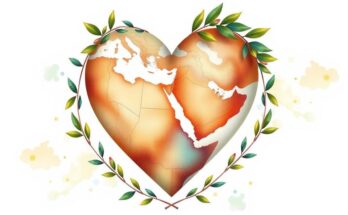2024 witnessed significant conflict escalations in the Middle East, marked by an intensifying battle between Israel and Hamas resulting in overwhelming casualties in Gaza. Concurrently, Israel’s military actions against Hezbollah in Lebanon and direct confrontations with Iran increased regional tensions. The swift downfall of Assad’s regime in Syria represented a major geopolitical shift, highlighting the interconnected and complex nature of conflicts throughout the region. The humanitarian crises emerging from these conflicts demand urgent international attention and intervention.
The year 2024 has been tumultuous in the Middle East, characterized by an intensification of armed conflict. The Israel-Hamas war, which began with significant attacks by Hamas in October 2023, has escalated, resulting in over 45,000 deaths in Gaza amid ongoing Israeli airstrikes and a comprehensive blockade. Concurrently, hostilities have erupted in Lebanon as Israel aimed strikes against Hezbollah, culminating in the death of the group’s leader, Hassan Nasrallah. Notably, for the first time in many years, Israel engaged directly with Iran, heightening tensions in the region. The political landscape in Syria also shifted dramatically with the fall of Bashar al-Assad’s regime to rebel forces, marking another significant upheaval in Middle Eastern geopolitics.
In Gaza, civilian life has been severely disrupted. The ongoing blockade has resulted in dire conditions, including widespread famine and a healthcare crisis. Humanitarian catastrophes have forced many to seek refuge in unstable shelters, leading to extensive displacement. Although Israel claims military successes against Hamas, negotiations for ceasefire remain elusive, as both sides experience ongoing casualties and escalated hostilities. In December, intricate diplomatic efforts for peace led by Qatar, the U.S., and Egypt are ongoing but face numerous obstacles.
Lebanon also found itself caught in renewed violence as Israel directed an extensive air campaign against Hezbollah, responding to the group’s rocket attacks. The conflict resulted in significant civilian displacement and substantial loss of life. Following the Israeli assassination of Hassan Nasrallah, Hezbollah retaliated with missile attacks against Israeli territory, highlighting the precarious balance in the region. A temporary ceasefire was eventually brokered at the end of November amidst international diplomatic interventions.
Relations between Israel and Iran reached a new low, particularly following Israel’s airstrike on the Iranian embassy in Damascus, which resulted in the targeted killing of a senior military commander. Iran’s subsequent missile attacks were largely intercepted by Israeli defenses, yet this series of exchanges escalated the military confrontations marked by Israel targeting Iranian sites. The unfolding scenario poses threats of wider war involving major powers and proxy conflicts across the region.
Furthermore, the political landscape in Syria experienced a seismic shift with the ousting of Bashar al-Assad, leading to a power vacuum and new leadership in the form of Turkish-backed rebel forces. The remarkable speed and efficiency of the rebels in seizing major cities underscored the declining power of Assad’s regime, which had previously maintained control for decades. This transition raises questions about Syria’s future governance and the potential for stabilizing the long-embattled state, with implications for the humanitarian situation across the nation as well.
In examining the events of 2024 in the Middle East, it is crucial to recognize the complex interrelations between various conflict zones and political entities. The Israel-Hamas conflict forms a central thread, exacerbated by historical tensions stemming from previous escalations in violence and territorial disputes. Meanwhile, Hezbollah’s involvement in the region, supported by Iran, showcases the broader sectarian and geopolitical contestations that fuel continued strife. The Syrian civil war, ongoing since 2011, has poignantly demonstrated the fragility of state authority, particularly with the Assad regime undergoing a dramatic downfall this year. These developments reveal the interconnected nature of conflict in this region, where local actions often reverberate across national borders, influencing stability and humanitarian conditions.
The year 2024 stands as a critical juncture in the Middle East, with intensified conflicts marking historical and humanitarian crises. The ongoing war between Israel and Hamas has led to severe casualties and humanitarian disasters within Gaza. Concurrently, the resurgence of conflict in Lebanon and the direct confrontations with Iran illustrate a deteriorating security environment. The dramatic fall of the Assad regime in Syria underscores the volatility of the region’s political landscape, suggesting that these conflicts will continue to have profound effects, not only locally but across the entire geopolitical spectrum. Only sustained diplomatic engagement can hope to bring about a resolution to these enduring crises.
Original Source: www.france24.com




